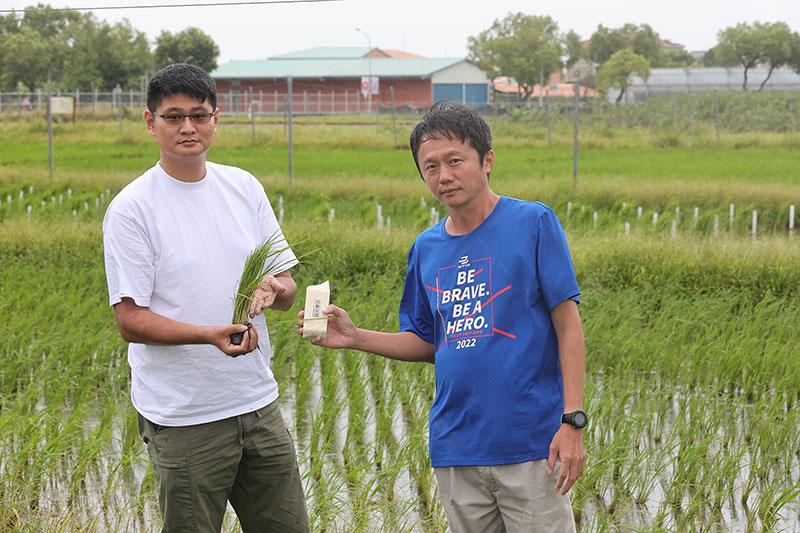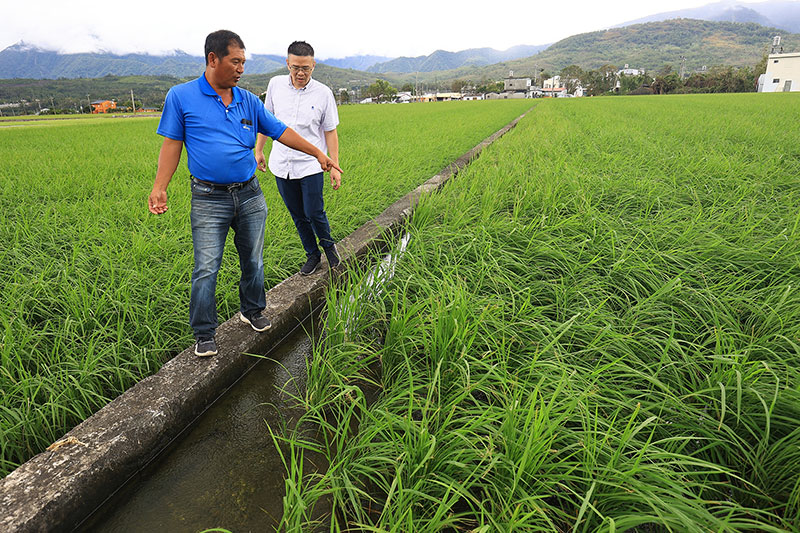
Huang Chia-hsing (right), associate researcher and breeding project leader, and assistant researcher Lee Jui-cha (left) have been the biggest drivers behind the Hualien No. 26 project.
Put some raw rice and other ingredients into a wok and stir-fry them. Then, gradually add your precooked broth. As the rice grains slowly cook through, they absorb the essence of the broth without clumping together, while achieving an al dente texture. Finally, top it off with some fourfinger threadfin, mullet roe, and fiddlehead greens, and voilà, a seafood risotto made entirely from Taiwanese ingredients is ready to be served. The star of the dish is a Taiwanese rice variety known for its soft yet toothsome texture—Hualien No. 26.
To make authentic Italian-style risotto, the Taiwanese food and beverage industry imports some 300 tonnes of Italian rice each year. However, with the one-two punch of the Covid-19 pandemic and a once-in-a-century drought in Italy, domestic importers have been left struggling to deal with the resulting shortage of Italian rice, and consequently many restaurants have had to temporarily stop selling risotto.
In June 2023, the Hualien District Agricultural Research and Extension Station (HDARES) of the Ministry of Agriculture announced that the rice breeding line HKB 228 had passed review and been given the name Hualien No. 26, becoming Taiwan’s first local rice variety suitable for making risotto. The news was welcomed by importers and restaurateurs alike as a solution to their problems.

In the fields, Matteo Wu (right) of rice importer Hsei Yi and Chien Hung-sheng (left), owner of Xin’an Grain and Food, check the condition of the growing rice.
East meets West
Breeding this new variety took seven years, but the seeds were planted much earlier in the mind of associate researcher Huang Chia-hsing, leader of the breeding project that gave rise to Hualien No. 26. However, the limited market of the time meant that the idea took time to germinate. Nonetheless, Huang and his partner, assistant researcher Lee Jui-chia, stuck to their grand vision. “Continuing to rely on imported risotto rice wouldn’t be of any benefit to Taiwan,” they say, “and that’s why we developed this variety. Beyond supporting the domestic food industry, the next most important thing is to break into the high-end foreign market.”
What makes a risotto rice? After carefully examining the three main varieties used in Italy—Carnaroli, Arborio, and Vialone Nano—Huang found they could be broadly identified by their high amylose content, large grain size, and large white core.
He believed that these characteristics were important factors in creating the al dente texture of Italian risotto. After selection, yield comparison tests, regional trials and a variety of other tests, a breeding line numbered HKB 228, the offspring of Vialone Nano and Taitung No. 30, stood out, and went on to be registered as a cultivar under the name ‘Hualien No. 26.’
Seeing seven years of hard work bear fruit, both Huang and Lee were overjoyed, but also add, “We thought we could finally relax, but then we realized how much further we still had to go after registering the name.”
Worth waiting for
The Hualien County townships of Fuli and Yuli are known for their pristine land and water, as well as unique characteristics derived from their geography like short daylight hours and large day–night temperature differences. These factors contribute to the production of high-quality rice, and thus they became the first home of Hualien No. 26 after the cultivar was officially named.
We accompany Matteo Wu, second-generation head of Hsei Yi Co. Ltd., an importer of Italian foods, as he visits Chien Hung-sheng, the owner of Xin’an Grain and Food and a prospective grower of Hualien No. 26.
Standing by the lush green paddies, Wu carefully inspects the condition of the rice, which was blown over by recent strong winds, while inquiring about its growth progress. Chien, who has decades of experience in rice cultivation, responds to Wu’s concerns in a relaxed tone, saying, “A few leaves might be damaged, but that doesn’t mean the crop will fail.”
While the comment has Wu sweating a little, he nonetheless retains his belief in Chien’s abilities. He explains that Xin’an’s major customer, the PX Mart retail chain, has a low tolerance of failure, and has built the company into a “crack unit.” Xin’an carefully manages the whole production process, from seedling cultivation and planting out to storage, milling, and packaging, and so is able to guarantee consistent quality. Wu further emphasizes, “The most important thing is their willingness to take on risks and challenges, which is why I’m willing to come and try this experiment.”
Wu had received many suggestions of other Taiwanese rice varieties to use directly for making risotto, but he was always sure there would be a better option. Now, with the advent of Hualien No. 26, he is confident that he was right to persevere.

Tsai Pin-han, the head chef of Restaurant Page, is dedicated to creating a fusion of Taiwanese and Western cuisine. Hualien No. 26 rice is set to be one of the ingredients he uses in his future culinary creations.
Risotto alla Taiwanese
After leaving home, Hualien No. 26 faces its final challenge in the arena of the dining table.
Restaurant Page, which since 2018 has been listed in the Michelin Guide for six years running in the “International” category, specializes in Taiwanese–Western fusion cuisine, taking many familiar Taiwanese dishes and preparing them in a Western style, and thus redefining “Taiwanese cuisine.”
Looking at the menu, one sees a number of unconventional combinations. Chef Tsai Pin-han explains, “Some people call it chaotic, but all I’m actually doing is rearranging the basics or replacing foreign ingredients with Taiwanese ones. This enhances the flavors while also giving more Taiwanese ingredients a chance to be seen.”
Every dish at Restaurant Page is another story, and just as a book can enrich the mind of the reader, these meals enrich the tastebuds of diners. Hualien No. 26 rice is set to play an important role in the newest chapter of Restaurant Page’s tale.
For Chef Tsai, this rice was something he had never expected. “I thought someone was playing a trick on me,” he jokes. This reaction, however, also demonstrates that Hualien No. 26 has indeed achieved HDARES’ goal—to develop a rice that could replace the Italian varieties.
Looking at it raw, Hualien No. 26 looks very similar to its Italian counterparts, and it’s also similar in terms of cooking time. However, while the Italian rices are focused on al dente texture, Hualien No. 26 is more about the soft and chewy “Q” texture that Taiwanese people are accustomed to, while keeping the grains intact.
For Chef Tsai, though, the ultimate goal of using Hualien No. 26 is not to make it taste like traditional Italian risotto. Instead, he believes that it should be used to create a unique Taiwanese-style risotto rich in Taiwanese flavor.
What makes a Taiwanese-style risotto? How should it taste? With the birth of Hualien No. 26, we have a chance to explore a new page in the story of Taiwanese rice and potentially even make waves internationally.
For more pictures, please click 《Redefining Taiwanese Risotto—The Birth of Hualien No. 26》











